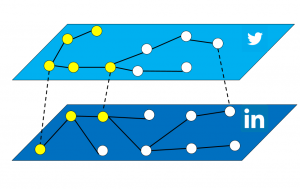 Overlapping users of social networks such as Facebook and Twitter link these online social networks into a multiplex of social networks. As different components of the multiplex may have different properties, the multiplex may exhibit emergent phenomena that isn’t present in the simpler case of single layer social networks. For example, diffusion is likely to occur by different processes and with different speeds; therefore, one problem we consider is the diffusion of influence in a heterogeneous multiplex: where each layer has a different model of diffusion. Given this heterogenity of diffusion, new approaches to problems such as Influence Maximiation (IM) and Threshold Activation Problem (TAP) may be necessary.
Overlapping users of social networks such as Facebook and Twitter link these online social networks into a multiplex of social networks. As different components of the multiplex may have different properties, the multiplex may exhibit emergent phenomena that isn’t present in the simpler case of single layer social networks. For example, diffusion is likely to occur by different processes and with different speeds; therefore, one problem we consider is the diffusion of influence in a heterogeneous multiplex: where each layer has a different model of diffusion. Given this heterogenity of diffusion, new approaches to problems such as Influence Maximiation (IM) and Threshold Activation Problem (TAP) may be necessary.
Objectives:
- Determine emergent phenomena arising from the added multiplex complexity
- Study heterogeneous diffusion processes and related problems
- Study problems where the diffusion speed are different for networks
Selected Publications:
- . “Supporting a Storm: The Impact of Community on GamerGate’s Lifespan,” in IEEE Transactions on Network Science and Engineering, 2019
- . “Least Cost Influence Maximization Across Multiple Social Networks,” in IEEE Transactions on Networking (ToN), 2015
- . “Least Cost Influence in Multiplex Social Networks: Model Representation and Analysis,” in Proceedings of the IEEE Int Conference on Data Mining (ICDM), 2013